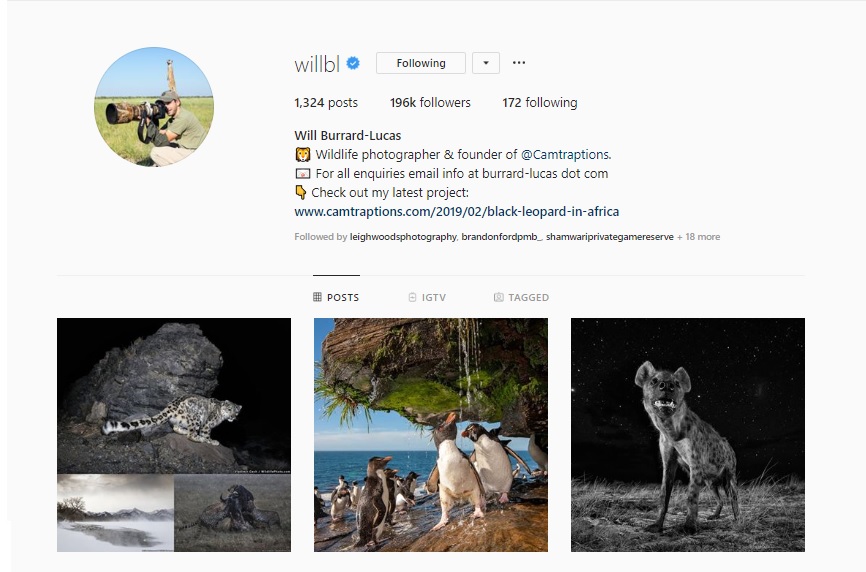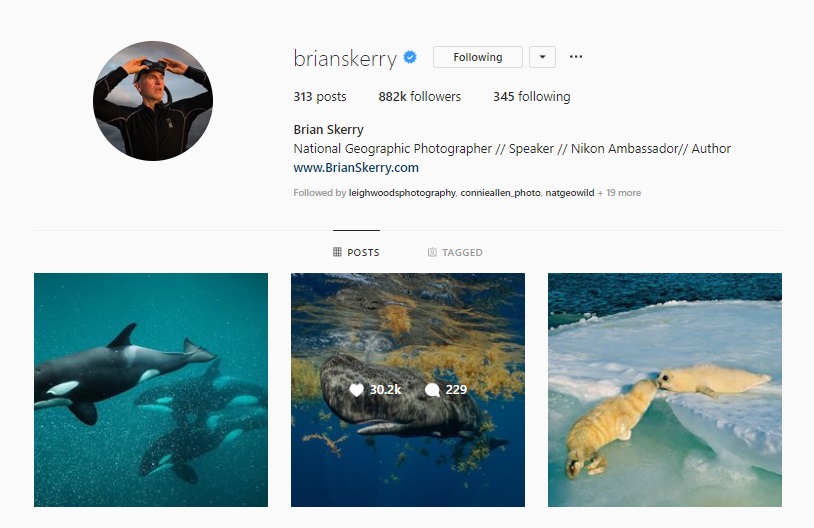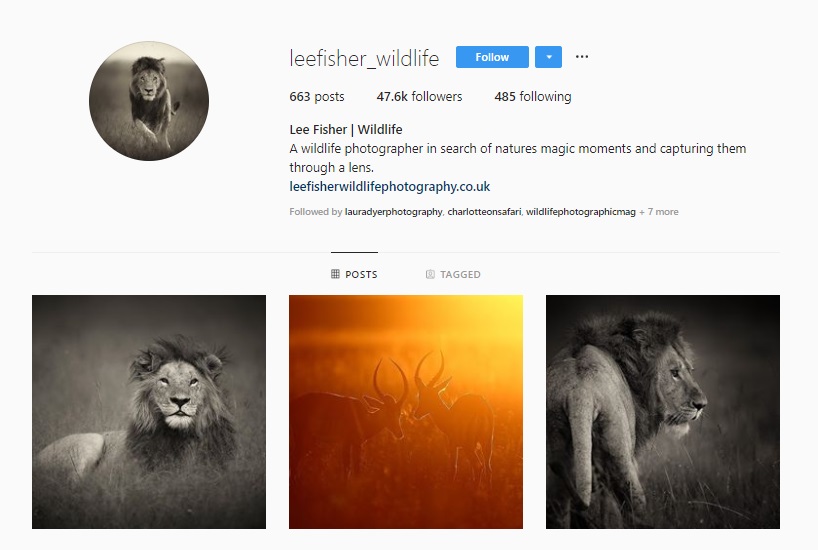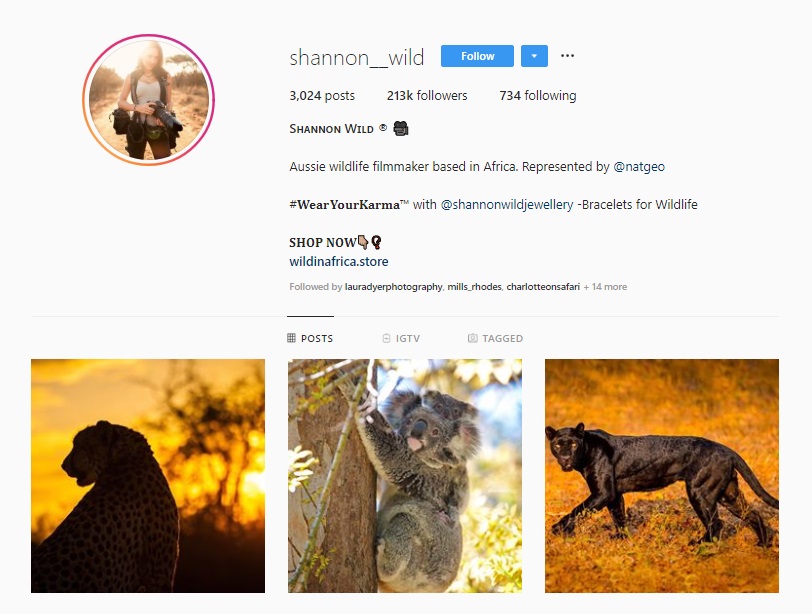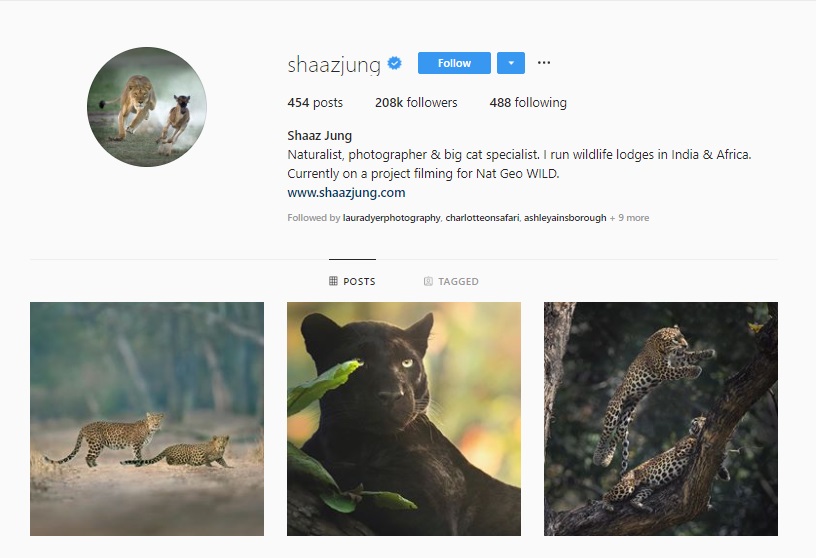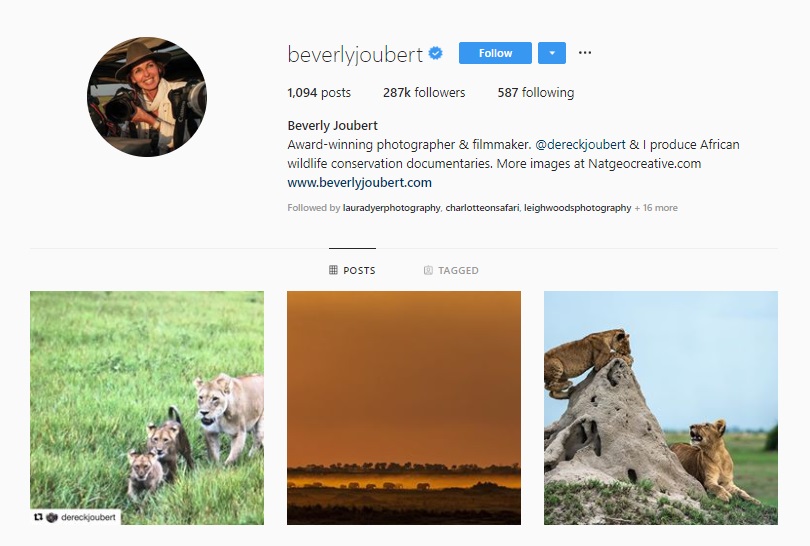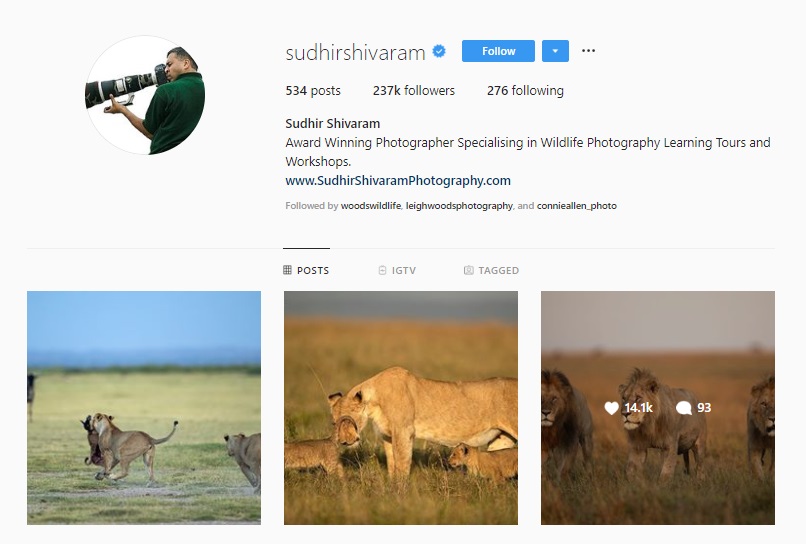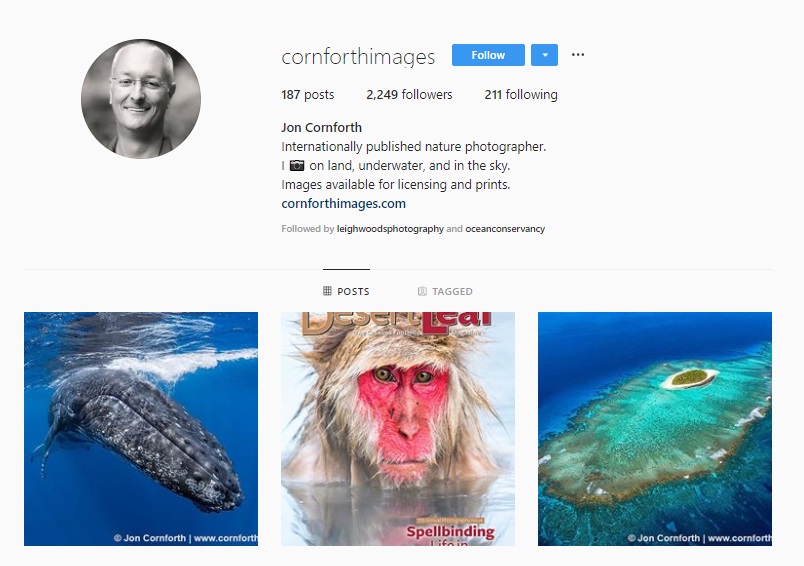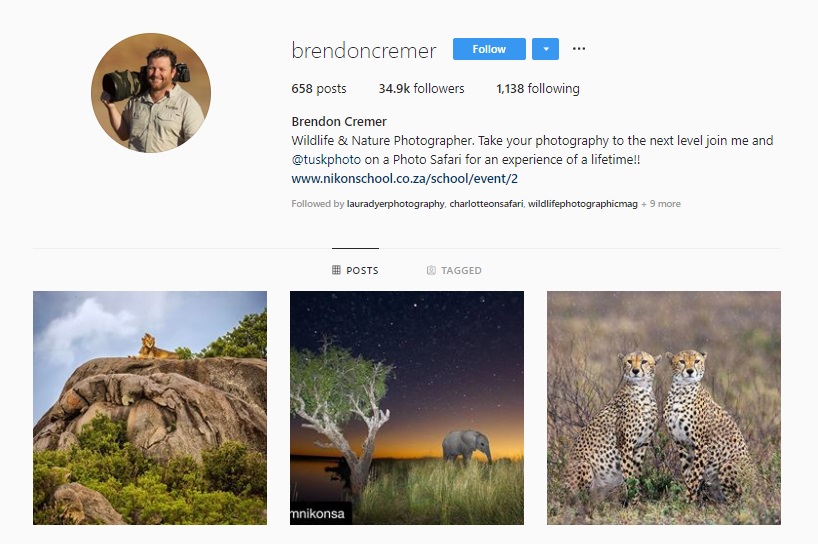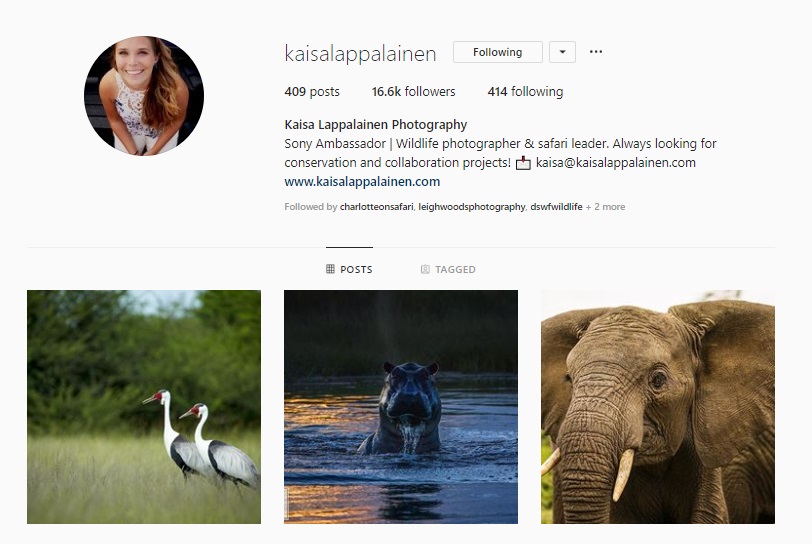Will Burrard-Lucas
With close to 200,000 followers, Burrard-Lucas is one of the most followed wildlife photographers on Instagram. He is somewhat of a pioneer in the industry, having invented new gadgets including “BeetleCam” and “BeetleCopter”. His "Camtraptions" have helped him to achieve beautiful wildlife images from very unique angles the latest of which includes incredible nighttime images of a highly-elusive black leopard in Kenya.
Click for Will Burrard-Lucas’s Instagram
David Lloyd
One of my personal favourites, David Lloyd is a New Zealand born photographer that has taken some of the best African animal shots out there. He is particularly skilled at capturing portraits that help the viewer to really connect with the subject and prefers to shoot in black and white. Lloyd’s fine art prints are often on exhibition and can be purchased on his website. For those based in the UK, look out for his photography workshops hosted by the British Wildlife Centre.
Click for David Lloyd’s Instagram
Konsta Punkka
Based in Helsinki, Finland, Konsta Punkka has managed to develop a style I am in total awe of. His wonderfully unique depiction of woodland animals including bears, foxes, and deer are truly a joy to behold. Most of his shots are moody and dramatic, with many other photographers aiming to emulate his work, but Punkka’s portfolio remains at the very top. A photographer whose work I'd happily decorate my home with.
Click for Konsta Punkka’s Instagram
Melissa Groo
Best known for her bird photography, Melissa Groo's feed contains perfectly composed shots often comprising soft hues and low contrast. Groo also posts some stunning images of mammals if birds aren't your cup of tea.
Click for Melissa Groo’s Instagram
LEIGH WOODS
Shameless, perhaps, but when you write an article on wildlife photographers that gets a lot of hits I think it’s okay for a little self-promotion. I draw inspiration from all of the incredible photographers on this list, but those who have influenced my work the most are Shaaz Jung, Konsta Punkka and David Lloyd. Like many of the incredible artists featured in this article, I’m passionate about conservation and use my work to raise funds for non-profits like The Born Free Foundation, whose mission is to keep wildlife in the wild.
Click for Leigh Woods’s Instagram
Brian Skerry
With over half a million Instagram followers, Brian Skerry is one of the most popular wildlife photographers on social media. A wildlife photojournalist for National Geographic magazine, he is an expert in marine wildlife and underwater environments. From the tropical reefs of the Indian Ocean to the freezing waters below the polar ice, Skerry has dedicated more than 10,000 hours to capturing amazing underwater images from all over the world.
Click for Brian Skerry’s Instagram
Richard Peters
Awarded "European Wildlife Photographer of the Year 2015", Richard Peter's work is artistically composed with a combination of dramatic lighting and a minimalist feel. Most of his images are animal portraits exhibiting intense emotion and expressions. His unique style enables the viewer to engage with the subject in a way that most other photographers can't achieve.
Click for Richard Peter’s Instagram
Lee Fisher
Up there with the best photographers on this list, Lee Fisher has an incredible portfolio of wildlife images comprising some of my personal favourite subjects (Lion, Leopard, and Deer). Each image is a work of art in itself and would grace the walls of just about any home.
Click for Lee Fisher’s Instagram
Shannon Wild
Shannon Wild is an Australian wildlife photographer and cinematographer based mainly in Africa. She is one of the few photographers that has mastered the art of creating vibrant and colourful photos without going too heavy with contrast or saturation. While most of her images contain African animals, she also has some amazing shots from the Arctic.
Click for Shannon Wild’s Instagram
Shaaz Jung
Shaaz Jung runs his own safari camps in southern India and spends most of his time in the forest. This lifestyle has afforded him the opportunity to capture some of the best images of big cats that I've ever seen. I am particularly in awe of the beautiful leopard shots in his collection.
Click for Shaaz Jung’s Instagram
Austin Thomas
Another top bird photographer who has attracted many Instagram followers for his photos of walking owls and close-up shots of bobbing pelicans. His feed also contains some magnificent images of birds of prey in flight.
Click for Austin Thomas’s Instagram
Brian Scott
This photographer has nailed the art of animal portraits and has a very similar style to that of Lee Fisher (particularly his black and white lion shots). All of his images have a very clean and crisp feel to them that makes them very pleasing on the eye. His work on birds draws particular attention.
Click for Brian Scott’s Instagram
Beverley Joubert
An award winning photographer and videographer, Beverly Joubert works with her husband Dereck to produce some of the most epic wildlife conservation documentaries including "The Last Lions" and "Eye of the Leopard". Most of her images reveal high contrasts with earthy tones. Her feed has a good mix of artistically composed and candid shots.
Click for Beverly Joubert’s Instagram
Sudhir Shivaram
Sudhir Shivaram is an award winning photographer that specialises in wildlife photography learning tours and workshops. Based in Bangalore, India, his work on tigers and Asian leopards are particularly noteworthy. Shivaram is one of the best photographers to follow for those who wish to develop their knowledge and skills in the art of photography.
Click for Sudhir Shivaram’s Instagram
Jon Cornforth
A great all-rounder with a portfolio of stunning photographs taken on land, underwater, and in the sky. Jon Cornforth is an award winning wilderness photographer that has built up a beautiful collection of images that he shares on his Instagram account. Personally, I'm a big fan of his humpback whale shots taken off the coast of Hawaii.
Click for Jon Conforth’s Instagram
Suzi Eszterhas
If you're into cute baby animals then Suzi Esztherhas is the one person on this list you should definitely follow on Instagram. Suzi has published over 100 magazine cover and feature stories worldwide, with her stunning images of animal mothers and their young being very popular with followers.
Click for Suzi Ezsterhas’s Instagram
Brendon Cremer
As a professional photo safari guide, Brendon Cremer has the added advantage that comes with knowledge in animal behaviour. His style is unique, with many of his images containing subjects in unorthodox poses. Some of the photos are very candid and his choice of composition is often out of the box, but that's what makes his work so interesting.
Click for Brendon Cremer’s Instagram
Kaisa Lappalainen
With one of the classiest portfolios on the list, Kaisa Lappalainen has managed to collect a fantastic set of images that cover a diverse range of species. She has managed to develop a series of striking wildlife photos without using heavy contrasts or vibrant hues. I'm a big fan of her work on bears, puffins, and orca.
Click for Kaisa Lappalainen’s Instagram
Morne Hardenberg
As a huge shark fan, I just had to put Morne Hardenberg on the list. Specialising in both photography and cinematography, his Instagram feed contains some spectacular shots of a wide variety of shark species. The Burrard-Lucas of the sea, he has managed to capture many of his photographs from very unique angles.
Click for Morne Hardenberg’s Instagram
Joel Sartore
I'm a particular fan of Joel Sartore because he uses his photography to draw attention toward conservation efforts to save endangered species. His animal portraits are incredibly beautiful and the type that one might stare at for hours. Be sure to follow Sartore if you enjoy close-ups and support conservation.
Click for Joel Sartore’s Instagram
Paul Nicklen
I've saved the wildlife photographer on this list with the most Instagram follows until last. With a whopping three million people following his feed, it's not hard to understand why he has so many fans given his exquisite portfolio. Hands down one of the best conservation photographers in the world, Nicklen is renowned for his marvellous work on both the north and south poles.
Click for Paul Nicklen’s Instagram
If you liked this article, you can also follow updates on similar articles by following my own wildlife photography Instagram account @woodswildlife
